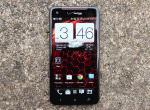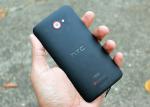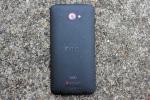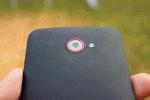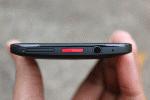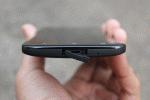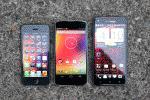
HTC has dutifully been churning out smartphones to fly under Verizon’s Droid banner ever since it released the Droid Eris in 2009, but in recent months the company seems to have lost some of its edge. That’s why HTC is looking at its new Droid DNA as something of a return to form — it’s attractive, and powerful, and sports a truly insane 1080p display (the first of its kind in the United States).
Now that all sounds great on paper, but how well does Verizon’s new top-tier Android smartphone work? Read on to find out.
- 5-inch Super LCD 3 display running at 1920×1080 — Verizon’s first 1080p smartphone
- 1.5GHz Snapdragon S4 Pro chipset, with 2GB of RAM and an Adreno 320 GPU
- Runs Android 4.1.1 laden with HTC’s Sense 4+ UI
- Only has 16GB of internal storage and lacks microSD card slot
- Sealed 2,020 mAh battery
- Available on November 21 from Verizon Wireless ($199 w/ 2 year contract)
I called the Droid DNA “awfully conservative” during my first go-round with the device, and that impression hasn’t changed much now that I’ve used it as my daily driver for the past week. That’s not to say I haven’t come to appreciate it though — while HTC’s earlier Droids (and some of their other Verizon smartphones as well) sported some truly funky design choices, the company has ceased its shenanigans and put together a much cleaner device.
Take the DNA’s front for instance. There’s really not much to see here — a trio of Android navigation buttons (Back, Home, and Recent Apps) are positioned precariously low on the DNA’s face, while a silver Verizon logo and a long, slim, red speaker grille are centered above the phone’s sizable display. The DNA’s 2.1-megapixel sits in the top left corner, and that’s pretty much the ballgame. It seems sort of dull at first, but HTC’s rationale becomes clear as soon as you fire up the device proper. The DNA’s unassuming front seems clearly made to shift as much focus onto that wondrous 5-inch 1080p Super LCD3 display as possible (more on that later).
Meanwhile, the DNA’s rear end is even more spartan than the front — it’s all dark grey soft touch plastic with a few splashes of a red trim around the 8-megapixel camera and in the form of the Beats Audio logo. There’s much more than meets the eye here though, and one of my favorite design flourishes can be found directly to the left of the camera pod.
In many cases you’d be hard-pressed to see anything at all unless you were specifically looking for it, but that all changes once you receive a text or an email and the semi-hidden notification light comes to life (don’t fret, there’s one in the front speaker grille too). Similarly invisible is the Qi-compatible wireless charging system that’s built into the DNA’s back, which I’ve gotten plenty of use out of this past week. Just be sure to keep your hands clean before you start playing with the DNA, as its rear plate seems to pick up smudges if you so much as look at it funny.
As I’ve noted before, the Droid DNA feels remarkably usable for a device of its stature — not once did I ever feel that the DNA was too big to handle (though your mileage may vary). That’s thanks in part to the DNA’s relatively light weight (4.86oz), which works nicely here even though I’ve always preferred the reassuring heft HTC’s devices usually have. The rest of the credit goes to the device’s curved back and tapered edges, which do an excellent job of making the DNA feel much thinner than it actually is. Let it never be said that HTC doesn’t know how to construct a great-feeling phone.
Not well is all in Droidland though, as some of HTC’s design choices left me puzzled and just a bit frustrated. Consider the DNA’s microUSB port for instance. It’s nestled dead-center along the device’s bottom edge, but it’s covered by a chintzy swiveling flap of plastic. I reacted with something approaching shock when I first spotted it, since it seems like ages since the last time a company saw fit to cover up a port like this. Were it up to me I’d just cut the thing off, but I imagine Verizon wouldn’t be too pleased to see that when its PR folks get this thing in the mail. Equally troubling is the entirely-too-small sleep/wake button that sits atop the DNA. It’s clad in red, which is handsome enough, but I’ve found it requires just a bit too much groping to find when I needed it.
Some of HTC’s design decisions are downright frustratingThose may seem like minor gripes, but here’s what gets me the most about the Droid DNA — it’s clearly meant to be Verizon’s flagship Android smartphone, but HTC apparently didn’t think it was necessary to include a microSD card slot. Really? I mean, really? Let’s not forget that every other Droid-branded phone HTC has ever made supported expandable memory. Why draw the line here? It doesn’t help that the DNA only comes with 16GB of internal storage (roughly 11GB of which are actually available to users from the get-go).
The DNA ships with Android 4.1.1 Jelly Bean installed, but as usual HTC has done its best to paint over Jelly Bean with the company’s custom Sense 4+ UI. All the usual Android 4.1 accoutrements are present and accounted for — Google Now (accessible by long-pressing the home key) is around to quietly keep tabs on your search history so it can surface relevant content later, and Jelly Bean’s Project Butter ably smoothes out animations and transitions — but you’d be hard-pressed to tell at first glance.
Long-time readers may know that I’m no great fan of those sorts of manufacturer-mandated modifications, but HTC has been consciously dialing down the once-overwrought Sense experience into something more subtle and fluid. I won’t spend too much time digging into Sense here — if you’ve seen any just about any recent HTC device, you already get the idea — but there are few minor changes worth noting. The stock Gallery app has also gotten a facelift since last I saw it, for one. In addition to letting users pore over photos stored on the device itself, it also lets them leap right into galleries stored on Dropbox, Facebook, Flickr, and the like (provided they’re signed in, of course).
I’ve also grown fond of the included HTC Notes application, if only because it’s so darned comprehensive. It leans heavily on Evernote for cloud storage, and timestamps typed notes if you also happen to have the recorder running — very thoughtful.
Verizon, please let us get rid of your bloatware.Curiously, the Sense keyboard gave me plenty of problems early on and I’m still trying to figure out what happened. I’m not talking about trouble getting used to its layout or spacing. The first time I fired up the DNA and plowed through its setup process, I found the keyboard attempting to make the most bone-headed substitutions (you should never have to add the word “his” to the keyboard’s custom dictionary) in every app I tried it with. It eventually got to the point where I had to reset the phone entirely, which seemed to clear up whatever malady had befallen the thing.
Ah, but Google and HTC aren’t the only players at work here. Verizon has sunk its fangs quite deeply into HTC’s take on Android. There’s a separate section for Verizon apps accessible from the app launcher, which plays home to classics like My Verizon Mobile, VZ Navigator (why does this still exist?), Viewdini, Amex Serve, and more. They’re easily disabled if you get irked by carrier bloatware, but really Verizon — would the ability to just uninstall these things really be that bad?
All right, this may seem like a copout, but the Droid DNA’s display is really one of those things that needs to be seen in person. You can read that “1080p” and “440 ppi” on a spec sheet (or hell, at the top of this review) over and over again, and it still wouldn’t really click until you saw the display in person. Text almost looks like it’s been printed on paper, images and icons are exceptionally crisp even when magnified to a ridiculous degree (see above), and high definition videos look downright amazing. In short, the DNA’s display is absolutely terrific… for the most part.
I found color accuracy to be very solid (if a hair oversaturated) all-around, but whites tended to take on a very slightly blue-grey cast. It’s also not the brightest display you’ll ever see, which will matter more to some of you than others. The iPhone 5’s screen shines considerably brighter than the DNA’s, as does the Nexus 4′s, though really, you probably won’t be ogling these devices side-by-side most of the time. Is it a bummer? Sure, but it’s hardly what I’d call a dealbreaker.
All things considered, the Droid DNA’s screen comes off as more evolutionary than revolutionary. It’s certainly a notable technical achievement (and one that Verizon will rightfully advertise the hell out of), but I don’t think there’s a phone nerd around who hasn’t seen the eventual shift to 1080p displays as a given. What’s more, I’d argue that the transition between oft-used 800×480 displays and something like Apple’s Retina display was more immediately jarring. That said, the Droid DNA’s display is generally a wonder to look at, and I eagerly await the day when panels like this are the rule instead of the exception.
Even though I’m not Sense 4’s biggest fan, HTC’s approach to the camera UI is still one of the best I’ve seen. Switching between shooting photos and videos is a very quick process, and I’ve found that the default settings are perfectly adequate for most situations. In case you’re more of a tinkerer, all of the main settings are within striking distance of your left thumb, from whence you can fiddle with exposure, ISO, face detection, and more. There’s virtually zero delay between the moment your thumb grazes the on-screen shutter button and when the photo is captured and saved (thanks to the DNA’s ImageSense chip), and the ability to save photos while recording video has gotten plenty of use this past week.
Naturally, none of that would matter much if image quality stunk, but that’s thankfully not the case. Test photos using the main 8-megapixel camera were crisp and detailed, and colors were vibrant, and even the 2.1-megapixel frontfacer yielded some decent shots thanks in large part to its impressive wide-angle lens. Performance in low-light situations is always dicey for these tiny sensors (unless you’ve got a Lumia 920 or something), and the DNA’s camera becomes more unremarkable as light levels dip. The resulting photos aren’t bad per se, just nothing to write home about. The DNA is also capable of recording 1080p video from either camera, and quality was on par with what I’ve seen in devices like the One X — smooth, nicely detailed, and plenty good enough for YouTube.
The DNA’s particular hardware configuration is one that’s getting plenty of attention lately. Like LG’s Optimus G (and, by extension, the Nexus 4) it sports a 1.5GHz quad-core Qualcomm Snapdragon S4 Pro processor and 2GB of RAM. It has already proven to be a potent mix in the past, and its benchmarks tell a familiar tale: its five-run Quadrant average topped out in the low 8,000s (compared to the Optimus G’s five-run average of 7,033, and the Galaxy Note 2’s 5,859). It performed equally nicely in Geekbench with an 1889, handily beating its cousin the One X+ (1547), though the Nexus 4 just barely squeaked by it (1961).
Of course, benchmarks aren’t everything. The DNA has more pixels to push than any other smartphone, so the potential for slowdown is certainly there. Thankfully, it’s been nothing but smooth sailing — I didn’t spot any unusual lag or visual stuttering, and all of the apps that I use on a daily basis (Google Voice, Chrome, Rdio, Twitter, YouTube, GTA 3, Minecraft Pocket Edition) look and run wonderfully. That’s obviously not to say that every app floating around in the Play Store is going to play nice with the DNA, but I haven’t stumbled over any glaring issues just yet.
Verizon data connectivity was consistently strong in my neck of the woods — nothing new there, really. The DNA managed average data speeds of 15.7 Mbps down and 5.9 Mbps up in my quiet little corner of New Jersey. When it came to calls though, the Droid DNA was strictly passable. Maybe it’s all the loud music I listened to growing up, but the main speaker volume was too soft for my liking even when cranked all the way up. I asked a few friends to listen in on some conversations just to remove any doubt, and they all reported the same thing (without prompting, there was no priming going on here).
You’ve been waiting for this, haven’t you? Yes, as you would expect, the combination of an LTE radio, a powerful processor/GPU pair, and that lovely 1080p display has led to some generally underwhelming battery life. In our standard battery run-down test (screen brightness set to 50 percent, with the device set to perform an endless loop of Google image searches over Wi-Fi and cellular data), the Droid DNA stuck it out for just shy five hours (4:50, to be precise) of continuous use before its 2,020mAh battery finally ran dry.
Now that’s not staggeringly worse than some of the other devices I’ve tested these past few months — the Nexus 4 only hung around for an extra 50 or so minutes — but the key words here are “continuous use.” When it came to actually using the device for checking emails, firing off text messages, and watching inappropriate YouTube videos throughout the course of a normal day, it usually lasted for around 6 to 6.5 hours before I had to reach for a charger.
Better, sure, but still not great. The DNA’s battery is easily the biggest question mark of an otherwise excellent handset. I can’t help but think of HTC’s particular choice of battery here as one of form over function, and I’m not thrilled with it.
When I first started playing with DNA, I was totally ready to dig into my bag of Star Wars cliches and tell you that this is indeed the Droid you’re looking for. Now, after using the thing non-stop for an entire week, I’m not quite as sure. Don’t get me wrong — for the most part, the Droid DNA is a truly excellent phone and I’m still downright smitten with the thing. It’s handsome, has more than enough horsepower to keep up with all but the most demanding users, and its screen is one of the best I’ve ever come across.
For those of you who embrace the bleeding edge and all its resulting foibles, buy this phone. The choice isn’t as clear-cut for everyone else, mostly because a handful of questionable decisions and curious oversights on HTC’s part mean that the DNA just isn’t as great as it could’ve been. A dearth of storage space and a wimpy battery are among the Droid DNA’s most notable misses, but if you’re looking for a shiny new smartphone as we descend into holiday madness, the DNA is definitely worth at least mulling over.
